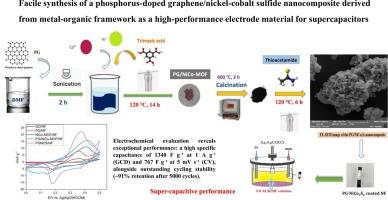Facile synthesis of a phosphorus-doped graphene/nickel-cobalt sulfide nanocomposite derived from metal-organic framework as a high-performance electrode material for supercapacitors
IF 6.3
2区 材料科学
Q2 CHEMISTRY, PHYSICAL
引用次数: 0
Abstract
In this study, a hierarchical phosphorus-doped graphene/NiCo₂S₄ (PGNCS) nanocomposite was rationally engineered as a high-performance electrode material for supercapacitors via a sequential solvothermal–calcination–sulfidation strategy. The design integrates phosphorus-doped graphene (PG) with a bimetallic NiCo-based metal–organic framework (MOF) precursor, synergistically combining high electrical conductivity with abundant and accessible redox-active sites. Comprehensive characterizations-including XRD, BET, FT-IR, Raman, TEM, FE-SEM, and EDS mapping-confirm the successful formation of a porous, well-anchored architecture with uniformly distributed elements. Electrochemical measurements reveal outstanding performance, delivering a high specific capacitance of 1340 F g⁻¹ at 1 A g⁻¹ (GCD) and 767 F g⁻¹ at 5 mV s⁻¹ (CV), along with excellent cycling stability (⁓91% capacitance retention after 5000 cycles). The superior charge-storage capability originates from the synergistic interaction between the conductive PG scaffold and the highly active NiCo₂S₄ phase, which together facilitate rapid electron/ion transport and enhance Faradaic utilization. This work highlights PGNCS as a promising and rationally designed electrode material for next-generation energy storage devices.

基于金属-有机骨架的掺磷石墨烯/硫化镍钴纳米复合材料的快速合成,作为超级电容器的高性能电极材料
在这项研究中,通过顺序溶剂热-煅烧-硫化策略,合理地设计了一种分层掺磷石墨烯/NiCo₂S₄(PGNCS)纳米复合材料作为超级电容器的高性能电极材料。该设计将磷掺杂石墨烯(PG)与双金属镍基金属有机框架(MOF)前驱体集成在一起,将高导电性与丰富且可接近的氧化还原活性位点协同结合。综合表征——包括XRD、BET、FT-IR、Raman、TEM、FE-SEM和EDS图谱——证实了多孔、锚定良好、元素均匀分布的结构的成功形成。电化学测量显示出优异的性能,提供1340 F g⁻¹在1 μ g⁻(GCD)和767 F g⁻¹在5 mV (CV)的高比电容,以及出色的循环稳定性(⁓在5000次循环后保持91%的电容)。优越的电荷存储能力源于导电PG支架与高活性NiCo₂S₄相之间的协同作用,两者共同促进了电子/离子的快速传递,提高了Faradaic利用率。这项工作强调了PGNCS作为一种有前途的、设计合理的下一代储能设备电极材料。
本文章由计算机程序翻译,如有差异,请以英文原文为准。
求助全文
约1分钟内获得全文
求助全文
来源期刊

Journal of Alloys and Compounds
工程技术-材料科学:综合
CiteScore
11.10
自引率
14.50%
发文量
5146
审稿时长
67 days
期刊介绍:
The Journal of Alloys and Compounds is intended to serve as an international medium for the publication of work on solid materials comprising compounds as well as alloys. Its great strength lies in the diversity of discipline which it encompasses, drawing together results from materials science, solid-state chemistry and physics.
 求助内容:
求助内容: 应助结果提醒方式:
应助结果提醒方式:


